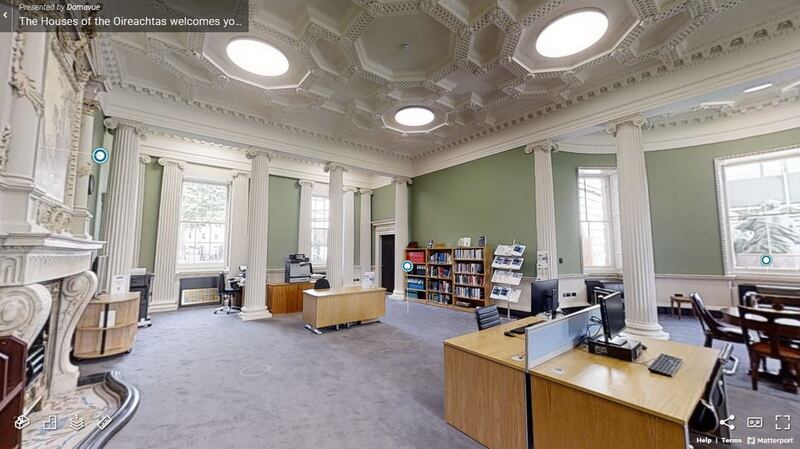Like most people, I was pretty shocked by the revelation that a very simple bike shelter on the Leinster lawn side of our parliament had cost the taxpayer €336,000. An online search shows a similar and perhaps more elegant structure, the Ark Cycle Shelter, available at a cost of €6,446.90 plus VAT. The area where the horrendously expensive structure has now been erected by OPW was previously marked out as parking space for three or four cars and was tarmacadamed.
Holding an inquiry within the OPW, as OPW Minister of State Kieran O’Donnell has now promised, is pointless. The damage has been done.
News that the cost included archaeological services adds insult to injury. As I pass the location almost every day, the archaeology, I can vouch, was confined to an excavation of less than two feet to make provision for a plinth of granite to replace the previous tarmacadam. Nothing of note was ever likely to be found two feet under the bike stand at the side wall of the basement-ed 19th century National Gallery. An array of electric charging points nearby has probably cost multiples of the bike shelter bill.
The wonder is that the freedom of information process ever brought the bike shelter scandal to public knowledge. Independent Senators have been trying unsuccessfully to use FOI requests to see plans being made by OPW to transform the beautiful members’ library at Leinster House, a protected structure, into what is termed a “main committee room” for the Dáil. The idea is that the Dáil’s weekly business could be simultaneously carried on in two chambers, with items like Taoiseach and Ministers’ questions being taken in the library space, while other business would continue in the present Dáil chamber.
Ireland weather: Met Éireann issues status orange weather warning for Co Wicklow
Alison Curtis: ‘On arriving in Ireland I was stumped at how men and women didn’t interact’
Houses evacuated after hillwalker takes home artillery shell
Power struggles, resignations and Conor McGregor’s toxicity: The fracturing of Ireland’s far right
The argument for parallel sessions is that it would obviate late sittings, making membership of the Dáil more family-friendly. But the Dáil would continue to sit three days a week only, on Tuesdays from lunchtime, 2pm-7.30pm; on Wednesdays, 10am-8.45pm with a one-hour lunchbreak; and on Thursdays from 10am to 5.30pm (with a 45-minute lunchbreak and un-votable private members business until 7pm). The beautiful members’ library has already been gutted of its fittings and furnishings in anticipation of such a change.
The room’s hardwood floorboards, specially commissioned handwoven rugs, reading tables, mahogany chairs and graceful uplighters have all been removed. The floor is now sheeted with wood composite panelling covered with carpet tiles. Ugly light fittings have been inserted into the beautiful coffered ceiling and tatty self-assembly desks scattered across the once-elegant space. Photos of the before and after of these changes are available online. It’s a very sorry sight. Although the library was, and remains, a protected structure, absolutely no permission has been sought from the planning authority for these mutilations from the planning authority, Dublin City Council.

Worse still, the total fixed cost of this main committee room proposal for the present library was calculated to be an astonishing €3,740,306.85 plus increased annual recurring operating costs of €1,633,759.21, ongoing every year. A bike shelter for €336,000 seems modest compared with these projected costs.
When this emerged at a Dáil reform committee in October 2023, there was consternation among the majority of members of the Dáil, and among Senators, none of whom was ever advised of the plan to cannibalise the library they share with TDs. Majority views of all members in both Houses, when consulted recently, are against these proposals.
It is clear that the proposal for a main committee room for parallel Dáil sessions would involve further major alterations of the beautiful, protected library with a glazed public gallery, a press gallery, permanent members’ seating, sound systems, camera and lighting fixtures, and secure, segregated internal access passages. Senators sought from OPW documents showing these proposed changes under FOI on four occasions without success.
While claiming that the documentation involved is too voluminous, OPW has offered none at all, nor even quoted a fee for complying with the requests. The matter is now being appealed as a matter of urgency to the Information Commissioner. Apparently, the cynical hope is that the controversy will die with this session of the Oireachtas in the coming months to be revived after the election.
It might make sense to hold a referendum limiting the size of the Dáil to, say, 160 instead of the current constitutional ratio of at least one TD per 30,000 of the population (which includes non-citizens). With 14 extra TDs in the next election, the Dáil is set to grow to 240 TDs over the next 25 years on current projections. Westminster’s House of Commons which, by the way, sits on Monday afternoons and Friday mornings, would have 2,400 members if they applied the Irish 1:30,000 ratio.
















